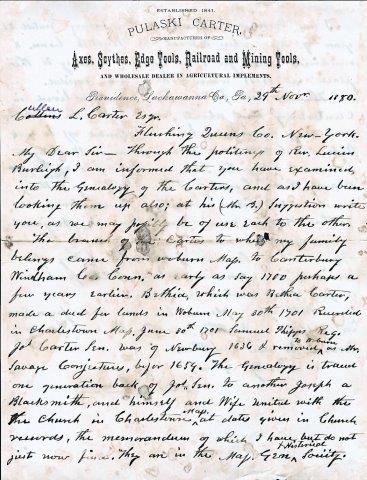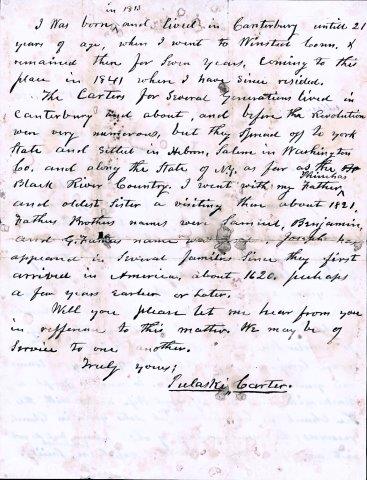Genealogical and Family
History
of the Wyoming and Lackawanna Valleys,
Pennsylvania.
Edited by Rev. Horace Edwin Hayden, 1906. Volume II,
pages 19 to 23.
[This also appeared, with some updates as
noted in {}
brackets, in HISTORY OF SCRANTON and Its People,
Vol II Scans of the Title page;
Pulaski Carter portrait; page 194; page 195; page 196; page 197; page 198; page 199,
by Col. Frederick L. Hitchcock, 1914]

PULASKI CARTER, deceased, was one of the
strongest characters
and most useful men of his day. He inherited in marked degree the
sterling
straits of his New England ancestry, and his name was ever a synonym
for
the strictest integrity and most uncompromising devotion to principle.
His family has been from the beginning of its history in America,
notable
for patriotism and public spirit of the highest quality.
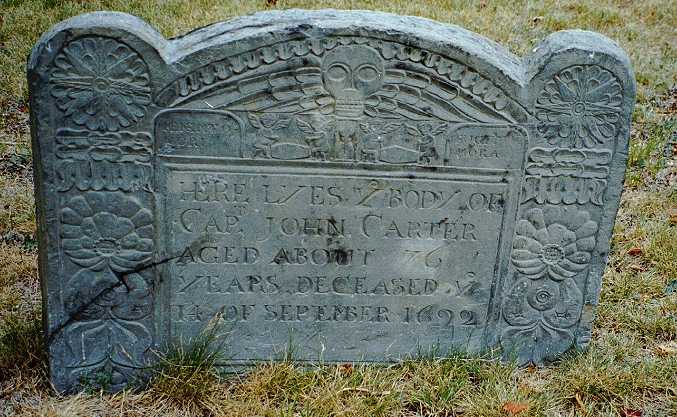
Gravestone of Captain John Carter, son of Thomas, Woburn, MA (photo
by Bob Carter)
The first Carters of whom we have authentic record in this
country are
Thomas Carter, blacksmith, and Mary his wife. Their names appear upon
the
church record in Charlestown, Massachusetts, in 1636. They were married
in England. Their children were: Thomas, Joseph, Samuel, John, Mary and
Hannah. The will of Thomas Carter, senior, was recorded in 1652. He
died
possessed of considerable landed property. His wife died in 1664, and
her
death is thus recorded: "Mary Carter, mother of the Carters in town."
Headstone in Westminster Church Cemetery,
Westminster, Canterbury, Connecticut
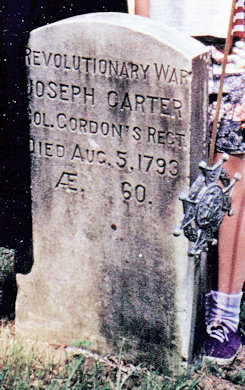 Joseph
Carter, second son of Thomas, was a currier. He married Susanna ---, in
1662. He was first of Charlestown, but later lived on the old Bellerica
road, Woburn, Massachusetts, with his son, Joseph, junior. He died
December
30, 1676. Joseph, junior, lived in Woburn, Massachusetts, married
Bethia
Pearson, and at his demise in 1692, left three sons and three
daughters.
His son John, born February 26, 1676, moved to Canterbury, Connecticut,
with his wife Mary about 1706. He was the father of John, junior, born
in Canterbury, February 24, 1709. John, junior, married Deborah Bundy,
and they had nine children. His son Joseph was born July 18, 1736. He
married
Patience Pellet, October 3, 1762. He served as quartermaster in the
Revolution,
and died August 15, 1796 (stone at left is wrong).
Joseph
Carter, second son of Thomas, was a currier. He married Susanna ---, in
1662. He was first of Charlestown, but later lived on the old Bellerica
road, Woburn, Massachusetts, with his son, Joseph, junior. He died
December
30, 1676. Joseph, junior, lived in Woburn, Massachusetts, married
Bethia
Pearson, and at his demise in 1692, left three sons and three
daughters.
His son John, born February 26, 1676, moved to Canterbury, Connecticut,
with his wife Mary about 1706. He was the father of John, junior, born
in Canterbury, February 24, 1709. John, junior, married Deborah Bundy,
and they had nine children. His son Joseph was born July 18, 1736. He
married
Patience Pellet, October 3, 1762. He served as quartermaster in the
Revolution,
and died August 15, 1796 (stone at left is wrong).
Phineas, son of Joseph and Patience (Pellet) Carter, was born
November
23, 1766. He was a landed proprietor of Westminster, Connecticut, and a
man of strong character and strict integrity, upright to the point of
austerity;
a devout Christian of the Congregational faith,
rigid
in exacting observance of religious forms and ceremonies; and strict in
his family discipline. He married Cynthia Butts, a woman of gentle
nature
and lovable traits of character. She was born March 16, 1773, and came
of a family of prominence in the public and private colonial life of
New
England. Her father, Deacon Stephen Butts, of Westminster, Connecticut,
born June 15, 1749, was the son of Joseph Butts, born March 17, 1711.
The
father of Joseph was Samuel Butts, who married Sarah Maxfield, July 22,
1701. Samuel Butts was a man of distinction in many respects, and the
record
of his official services is preserved in the archives of the state of
Connecticut.
He was elected thirteen times to the colonial assembly from Canterbury,
Connecticut, during the period 1715 and 1729, and was otherwise
conspicuous
in the community. His father was Richard Butts. He married Deliverance
Hoppin, daughter of Thomas and Elizabeth Hoppin, who came from England
to Dorchester, Massachusetts, in 1636. Phineas Carter died November 8,
1840, long surviving his wife, who died March 19, 1814.
Pulaski Carter, son of Phineas and Cynthia (Butts) Carter,
born in Westminster,
Windham County, Connecticut, June 23, 1813, was only nine months old
when
his mother died. His father desired for him the career of a physician,
and was much disappointed when the young man's inclination turned
toward
mechanics, and he went to Brooklyn, Connecticut, where he learned
blacksmithing.
On completing his apprenticeship he went to Winsted, Connecticut, where
he entered the shop of Captain Wheelock Thayer, and there gained a
thorough
practical knowledge of scythe-making. He first visited Pennsylvania in
1840, at which time he went to Honesdale and several other localities,
finally deciding to locate in Providence (now the first ward of
Scranton).
In 1841 he returned there and engaged in scythe-making. In June of the
following year, in company with Jerrison White, he purchased the Sager
& White Axe factory, and began the manufacturer of axes as well
as
scythes—the first factory of the kind in the state. He shortly
afterward
acquired his partner's interest, and in 1843 associated with himself a
boyhood friend, Henry Harrison Crane. Mr. Crane subsequently disposed
of
his interest in the business, but still remained in the works. Mr.
Carter
then took as partner Artemus Miller, but this partnership was soon
dissolved,
Mr. Carter assuming the entire ownership and management of the
business.
Meanwhile Mr. Carter had laid the foundations of the
enterprise which
came to be known as "The Capouse Works" (so named after the old Indian
chief of the Monseys, from whom also the Capouse Meadows received their
name), purchasing a thirty-acre tract of land from Henry Heermans, and
erecting thereon shops, etc., sufficient to commence business, and here
was made the wide reputation of the "Carter axes" which were for many
years
unrivaled. In 1864 the factory burned down, entailing a most serious
loss,
the insurance being wholly inadequate to defray the cost of rebuilding.
In this hour of his great disaster, Mr. Carter was proffered abundance
of financial aid by persons who appreciated his enterprise and had
implicit
confidence in his ability and integrity. These evidences of confidence
he gratefully declined, and he build and equipped an entirely new and
improved
factory which for many years was one of the important industries of the
valley, and this was accomplished with the preservation of that
personal
independence and self-reliance of which he was so justly proud. [In
1864 Pulaski Carter incorporated under a new name with
partners and the ability to sell stock. Perhaps Amelia was not informed
of this.] His business
career ended only with his death, and he maintained to the last his
deep
interest and pride in the great enterprise which was the creature of
his
own brain and hands.
In his relations to the community at large, Mr. Carter bore
himself
with the same dignity and conscientiousness that characterized the
conduct
of his business affairs. Whatever claimed his attention received from
him
the deepest interest and best efforts of which his heart and mind were
capable. The parental training had indoctrinated him with the loftiest
conceptions of an all-comprehending morality, and, when he first left
the
paternal roof, he came under influences which intensified his thought
along
the same lines. In the first days of his blacksmith apprenticeship,
youth
as he was, he became acquainted with the philosophy of the famous
Concord
and Brook Farm School. This was brought about through the Unitarian
minister
at Brooklyn, Connecticut, the Rev. Samuel J. May (intimate friend of
William
Lloyd Garrison, Wendell Phillips and Ralph Waldo Emerson), who allowed
him free access to his library and aided him in his reading. So
impressed
was the young man wit the field of thought to which he was thus
introduced,
that in after years he was able to repeat from memory entire pages from
the volumes which he read in those early days, and the sentiments which
he imbibed colored his whole life. A signal exemplification of this was
seen in 1846, when the free school idea was first broached. With a
heart
inspired with the most liberal New England ideas as to education, Mr.
Carter,
then a young man of thirty-four, threw himself into the struggle with
all
the intensity of his nature, and traversed the valley back and forth,
preaching
the gospel of free schools. An earnest and forceful speaker, he
produced
a deep impression. Nor was he content with this effort; he followed his
appeals with labors of organization, and, when the question came before
the people, had his followers so well in hand that a decisive victory
was
won at the polls. Thus was the free school planted in Providence, at a
time when Scranton was little more than a name upon the map. Mr. Carter
followed his success with yet more practical effort, donating the land
on which was erected the first free school building in the place, and
he
maintained an undiminished interest in educational affairs throughout
his
life. In 1857 the first graded schoolhouse was built, and in the public
celebration of that event Mr. Carter was awarded high praise as the
corner-stone
upon which the free school cause had been founded. For twenty-eight
years
he served as director and treasurer of the Providence school board, and
this fact speaks yet more eloquently of his heartfelt interest in the
cause
which he had so long and faithfully championed, for, naturally of a
retiring
disposition, and averse to public prominence, he had steadfastly
declined
the mayoralty and other important positions which he was solicited to
accept.
His considerate humanitarianism found eloquent expression in his
efforts
in behalf of temperance. His voice was ever heard in denunciation of
the
evils of the liquor traffic, persistently opposed to granting of
licenses,
and the saloon keepers greatly dreaded and feared him. But he went far
in advance of the great mass of temperance agitators. He gave his
personal
effort to the reclamation of the drunkard, and rescued many a one from
a life of poverty and shame, and aided him to an honest and happy
establishment
in life.
Mr. Carter was twice married, first, August 5, 1839, to Susan
S. Spaulding,
of Abington, Connecticut, about the time he had completed his trade,
and
two years before he located in Providence. The year of his coming
(1841)
a child was born to them, but death claimed the young mother a month
later,
and in the following summer the little one also died.
Mr. Carter married (second) August 7, 1843, Olive Ingalls, of
Canterbury,
Connecticut, a double cousin of his first wife. Her ancestry is traced
to the early colonial period, her emigrant ancestor being Edmund
Ingalls,
son of Robert Ingalls, and grandson of Henry Skirbeck. Edmund Ingalls
was
a native of England, born in Lincolnshire in 1598. He came to Salem,
Massachusetts,
in 1628, with Governor Endicott’s company. In 1629, with his brother
Francis
and four others, he founded the settlement at Lynn, Massachusetts. In
1648,
while traveling on horseback to Boston, he came to his death by
drowning
in the Saugus river, the accident resulting from a defective bridge.
His
son Henry, born in 1627, died 1719, was a landowner in Ipswich, and was
one of the first settlers of Andover, where he bought land from the
Indians,
making payment with clothing and trinkets. He was a wealthy man for the
times, and took a leading part in town affairs. He married Mary Osgood,
July 6, 1653, a daughter of John Osgood, who was the first
representative
to the general court from Andover, in 1651. It is the first record of a
marriage in Andover. The ceremony was performed by Rev. Simon
Bradstreet,
following the Puritan doctrine and belief in marriage as a civil
compact.
Their son Henry, like his father, was prominent in colonial affairs.
Joseph
Ingalls, son of Henry, Jr., was born in Andover in 1697, and married
Phoebe,
daughter of John Farnham. Their son, Joseph, Jr., born 1723, removed to
Pomfret, Connecticut; he married Sarah Abbott, daughter of Paul and
Elizabeth
(Gray) Abbott, and died in 1790.
Their son, Peter Ingalls, born 1752, died 1783, served in the
war of
the Revolution. He married Sarah Ashley, and the homestead built by him
is still standing and remains in the ownership of descended relatives
of
his daughter, at Elliott, Connecticut. His son Marvin, who served in
the
war of 1812, born 1789, married Amelia Spaulding, who came from an old
colonial family. Her father, James Spaulding, lived at Windham, and was
one of Putnam’s militia that marched to Lexington, and was also in the
company that marched to Cambridge in the early period of the
revolutionary
war, and his name appears on the pension roll of Revolutionary soldiers
in 1815. He was descended from Edward Spaulding, whose family records
go
back to an early period of English history, and numbered at least one
eminent
divine among its members. Edward Spaulding settled in Braintree,
Massachusetts,
between 1630 and 1633, where he was prominent in town affairs, being a
selectman and also for many a surveyor of highways. He was a landed
proprietor
and left a large estate. The crest of the Spaulding family bears the
motto
"Hinc mihi salus."
Pulaski and Olive (Ingalls) Carter had three children: Amelia
Maria,
Pulaski Pliny, and Marvin Phineas.
Amelia Maria Carter was born April 29, 1844. She married
William DeWitt
Kennedy, February 11, 1868.
Mr. Kennedy is of Scotch-Irish and French-Dutch ancestry. One
of his
ancestors of his mother's side was chaplain in Cromwell’s army. His
father
was James Schofield Kennedy. He was the son of Thomas and Elizabeth
(Schofield)
Kennedy. The father of Thomas was John, whose family was of
Scotch-Irish
lineage. He was born April 24, 1739, and came to America from Bangor,
Ireland,
in 1763. He was of the Scotch Presbyterian faith. He settled in
Kingston,
New York, and later married Mrs. Josiah (Armstrong) Van Fleet, widow.
Soon
after his marriage in 1780 they moved to Wyoming Valley.
His mother was Pauline Jayne (the original form of the family
name being
"De Jeanne") the daughter of Samuel and Elsie Stephens Jayne, the
latter
being the daughter of the Rev. David Jayne, whose wife was Elizabeth
DeWitt,
a cousin of the wife of General James Clinton, of Revolutionary fame.
The
grandfather of Mrs. Kennedy, the Rev. David Jayne, served in a New
Jersey
regiment in the Revolution, and took up a large and valuable section of
"soldier land" near Lake Cayuga, New York. Her grandfather, Ebenezer
Stephens,
entered the Revolutionary army at the age of seventeen, and remained in
service the entire seven years of the war. He drew a pension at
Wilkes-Barre
as long as he lived.
Mr. Kennedy is a director of the Scranton Savings Bank, and is
otherwise
prominent in the business life of the city. He was many years a trustee
in the Providence Presbyterian church, and now serves in the same
capacity
in the church at Green Ridge, his present place of residence. He served
in the war of the rebellion in the Thirtieth Regiment Pennsylvania
Reserves,
during the emergency, when the state was invaded, and the last year of
the war as quartermaster's clerk in the Fiftieth New York Regiment
(Engineer
Corps), and is now a member of Ezra Griffith Post, No. 139, G. A. R.
Mrs. Kennedy graduated from East Greenwich Seminary, East
Greenwich,
Rhode Island, in 1865. She has been for many years interested in the
philanthropic
movements of the city, particularly in connection with the Home for the
Friendless. She has been on its board of managers for twenty-three
years,
and has held many offices from secretary to president. For some years
she
has been vice-president of the Young Woman's Christian Association. For
thirty years she was an active member of the Providence Presbyterian
church,
but since 1893, has been identified wit the Presbyterian church at
Green
Ridge.
Mr. And Mrs. Kennedy are the parents of four children: 1.
William Pulaski,
born October 30, 1869, graduated from Scranton high school, class of
1889.
He is teller of the People's Bank of Scranton. He married Georgina,
daughter
of George R. Kittle, who was also a graduate of Scranton high school,
class
of 1889. 2. Dr. Lucius Carter, born September 8, 1872, graduated from
Princeton
College in 1895, and from the medical department of the University of
Pennsylvania
in 1898, and is now a practicing physician in Scranton. 3. Kathrine
May,
born November 11, 1875, graduated at School of Lackawanna, and is the
wife
of Dr. William A. Sherman, of Newport, Rhode Island, who is descended
from
one of the first settlers of Rhode Island. He graduated from Harvard
College
in 1899, and from the medical department in 1902. 4. Harold Sherman,
born
November 28, 1884, graduated at Blair (New Jersey) Academy, class of
1905.
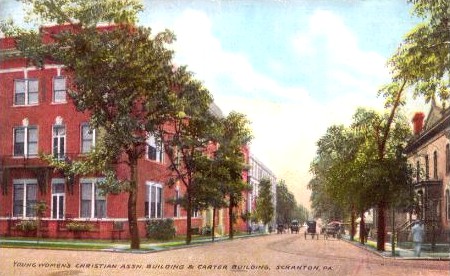
YWCA and Carter Building [built in 1896], Scranton, PA, c. 1909
Pulaski Pliny, second child of Pulaski and Olive (Ingalls)
Carter, was
born June 6, 1849. He was educated at East Greenwich, Rhode Island, and
at Fort Edward Institute. He is largely interested in real estate
enterprises,
and is owner of the large office building at the corner of Adams avenue
and Linden street, Scranton. He married, June 6, 1882, Venitia White,
born
February 11, 1862, daughter of Joseph M. and Phebe A. (Cole) White,
daughter
of Immanual Cole, the latter of excellent English descent. Joseph White
was the son of Ephraim White, of White's Mills, near Honesdale, who was
the son of Ezekiel White (Third) the son of Ezekiel White, Jr., and
Sarah
Vinton White. He was the son of Ezekiel White (1st)
who married
Abigail Blanchard. Ezekiel (1st) was the son of
Captain Ebenezer
White, whose wife was Hannah Phillips. Captain Ebenezer was born in
Weymouth,
Massachusetts, and was a son of Thomas White (wife's name unknown) who
was admitted a freeman in Massachusetts colony 1635-6. Place of
nativity
in England unknown. He was among the early settlers of Weymouth, and a
member of the church there; many years a selectman, often on important
committees, and also commanded a military company, and was
representative
to the general court in 1637, 1640, 1657 and 1671.
There were born to Pulaski Pliny and Venitia (White) Carter,
six children:
1. Pulaski, born June 2, 1883, a graduate of the Scranton high school,
class of 1903, now a sophomore at the Boston School of Technology {and
Columbia University; married Pearl Lidstone}. 2. Phebe, born September
14, 1885, graduated of the Scranton high school, class of 1904
{educated
Smith College, Northampton, Massachusetts, and Columbia University,
receiving
the degree of A. M. in 1913 [sic]; teacher in Technical High School,
Scranton}.
3. Ina, born March 1, 1888, died January 26, 1897. 4. Olive Ingalls,
born
November 9, 1890, senior in Scranton high school {educated Smith
College,
Northampton, Massachusetts, and Columbia University, receiving the
degree
of A. M. in 1913; teacher in Meriden High School, Meriden,
Connecticut}.
5. Ada, born November 3, 1893 {educated in Scranton High School and
Smith
College, attending the latter institution at the present time (1914)}.
6. Roy, born July 13, 1899 {a student in Scranton High School}.
Marvin Phineas, youngest child of Pulaski and Olive (Ingalls)
Carter,
was born November 28, 1857. He was graduated at East Greenwich, Rhode
Island.
He is one of the successful business men in Scranton, the owner of
valuable
real estate, a director in the People's Bank, and otherwise actively
identified
with the business of the city. He married Minnie Parmelia Murphy, born
June 26, 1863, daughter of John {Archbald} Murphy, of Warrenville,
Connecticut.
He was several times elected to the state legislature, and is a man of
business prominence in the town where he resides. Her mother was Mary,
daughter of Benjamin Spaulding, descended from Edmund, who came to
Braintree,
Massachusetts, about 1630. To them were born three children: 1. Marvin
Clarence, born July 29, 1885, a graduate of the high school, class of
1905,
freshman in Lafayette College {graduated}. 2. Lucius, born November 20,
1887, died June 3, 1889. 3. Marguerite, born May 30, 1889, a senior in
Scranton high school {graduated, graduated of Mr. Holyoke College, Mr.
Holyoke, Massachusetts}.
Mr. Carter, the father of the family above named, whose career
as a
man of affairs and a humanitarian has been treated of in the foregoing
narrative, met with a dreadful accident from the effects of which he
never
entirely recovered, and which doubtless shortened his life. In
November,
1876, while driving in his carriage, his vehicle was driven into one
each
side by two teams driven by drunken racers. Mr. Carter was caught in
the
wreckage and so seriously injured that for some days his life was
despaired
of. His excellent constitution, unimpaired by reason of his abstemious
habits, enabled him to resume his accustomed avocations, but he never
regained
his old vigor. He died October 13, 1884, aged seventy-one years,
leaving
to survive him his widow and their three children. His widow died
December
8, 1898.
[This also appeared, with some updates as noted in {
} brackets,
in HISTORY OF SCRANTON and Its People, Vol II pages
194-99, by Col.
Frederick L. Hitchcock, 1914]
This letter was purchased from an eBay seller in Florida. Pulaski
Carter wrote an outline of his genealogy to someone he was told was
interested.
Susan Carter White
Pieroth 2000-2018
New Rolling Mills
at Providence
Carter & Kennedy in Dunmore
Cemetery, Scranton, Pennsylvania
Return to the Carter
and Kennedy Main Page



